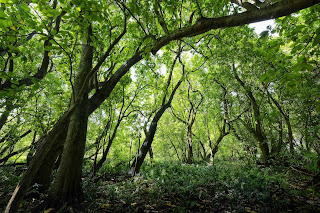There are lots of interesting things about native forests in the Islands, and The Nature Conservancy has just added an important one.
These forests do a better job of capturing carbon than
planted forests, at least in the example of Palmyra Island, where the Conservancy
and the U.S. Fish and Wildlife Service operate an atoll refuge a few hundred
miles south of Hawai’i.
Native Hawaiian forests are excellent at capturing moisture
and preventing aggressive, eroding runoff. That is in part due to the
complexity of the Hawaiian forest. There are generally canopy trees, and
smaller understory trees and shrubs and at the lowest level, ferns and mosses.
So when a heavy rain falls, its downward force is diminished
by all the leaves and branches it encounters on the way down, and then the
forest soaks it up like a sponge. So mountain streams in native forest areas
run clear, not muddy. And they keep running even after weeks of dry weather, as
the natural spongy forest floor lets the water seep out slowly.
By contrast, in a forest dominated by alien trees, like eucalyptus
or Java plum, there is little understory growth. And heavy rains often lead to
muddy runoff, eroded gullies, and sediment-filled streams. And shortly after
the rain stops, the soils dry out.
A new study at Palmyra by The Nature Conservancy has shown
that another benefit of native forests is that they also store more carbon than
single-species forests like the coconuts that once dominated Palmyra’s coralline
ground.
The paper was published in PLOS One by Kate Longley-Wood, Mary
Engels, Kevin D. Lafferty, John P. McLaughlin and Alex Wegmann. The title: Transforming
Palmyra Atoll to native-tree dominance will increase net carbon storage and
reduce dissolved organic carbon reef runoff.
At Palmyra, the Conservancy has been replacing dense coconut
stands, which are not native to the island, and were planted to promote a copra
industry, with the native forest that once existed there. They knew there would be impacts of this conversion,
but it wasn’t entirely clear what they would be.
“To better understand how this landscape-level change will
alter the atoll’s carbon dynamics, we used field sampling, remote sensing, and
parameter estimates from the literature to model the total carbon accumulation
potential of Palmyra’s forest before and after transformation,” the authors
wrote.
Their research showed that the new forest increased carbon
storage on the atoll’s land areas by nearly 12 percent, and also reduced the
flow of dissolved organic carbon into the island’s lagoon. That, in turn, is
expected to result in healthier corals and a strong community of the species
reliant on the coral reefs.
“We’ve demonstrated that better stewardship of natural
resources can increase their carbon capture ability,” said lead author Kate
Longley-Wood, Ocean Mapping Coordinator with TNC’s Protect Oceans, Lands and
Waters program. “That native tree species are better for carbon capture and
ocean health is the icing on the cake.”
All that said, it takes time for the effect to be seen, and
the story will likely change somewhat over time as the restored forest matures.
There is a loss of carbon in the standing trees when the coconuts are cut down
and allowed to be replaced by native Pisonia grandis (Pu’atea in
Tahitian or cabbage tree in English), Heliotropium foertherianum (beach
heliotrope), Pandanus tectorius (hala or screwpine) and other species
native to the atoll.
The native species are considered to be superior habitats
for native seabirds, they store more carbon, and they support a larger native
ecosystem. But the results don’t mean
it’s appropriate to go around cutting down all the coconuts elsewhere, as they
could be important parts of the human communities on some islands. The
scientific name of coconut is Cocos nucifera, sometimes written C. nucifera.
“C. nucifera’s role in human migration and settlement
throughout Oceania is notable, and control of C. nucifera to transform native
forest should be balanced with the societal value provided by C. nucifera to
Pacific Island communities,” the paper said.
© Jan TenBruggencate 2022

No comments:
Post a Comment